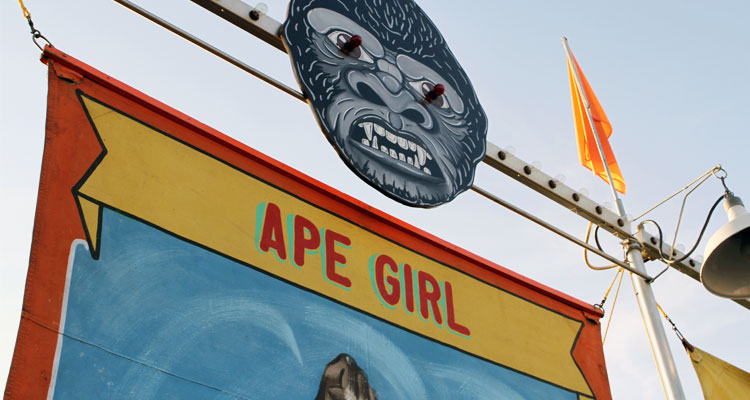Take a stroll through a carnival or a state fair and you may stumble across a remnant from the past. There, tucked away behind the Ferris wheel and the game where you sink ping pong balls in fish bowls, is the sideshow. The “freak show.” Sword swallowers, bearded ladies, alligator men. Though nowhere near as ubiquitous as they were during the late 19th and early 20th century, sideshows still cling to life in the technology-addled modern world, reminders of simpler (and stranger) times.
That unlikely persistence is at the heart of Ape Girl, a wonderful new documentary by Milwaukee filmmaker Cris Siqueira. The 60-minute film, which was named Best Documentary Feature at this year’s Coney Island Film Festival, will make its Milwaukee premiere at a free screening Sunday, November 11 at Sugar Maple. Lilly Czarnecki’s 11-minute short Belly Of The Beast will accompany the film. Both filmmakers attended graduate school at the University of Wisconsin-Milwaukee.
“Ape Girl is the result of almost 20 years of involvement with the Brazilian circus and the American sideshow, and six years in the making,” Siqueira says in a director’s statement. “It is also a radically independent project. I worked with a small crew during production, but shot much of the footage and edited the movie myself.”
APE GIRL TRAILER from Cristina Siqueira on Vimeo.
As its title suggests, Ape Girl traces the history of the “girl-to-gorilla” show, a sideshow attraction where a woman appears to transform into, well, a gorilla. It’s a dizzying, globe-trotting affair that spends time with Brazilian carnival owners, American showmen, and, of course, past and present “girl-to-gorilla” women. Incredibly, Siqueira was once one of those women herself.
“In June of 2008 I was made an offer I couldn’t refuse: I was invited to be ‘Monga’ the ape girl. On vacation from graduate school in Milwaukee, I had plenty of time to hit the road and turn into a gorilla 30 times a day,” she says. “I came back to visit the sideshow every summer in different capacities, from ticket seller, to bally girl, snake charmer and front talker, culminating with an entire season in the carnival in 2011. In the same period, I took advantage of my frequent trips to Brazil to rekindle with old circus contacts and begin an investigation of the country’s girl-to-gorilla shows.”
Ape Girl comes complete with an infectious original soundtrack from an eclectic group of Milwaukee, Chicago, and São Paulo musicians. Space Raft’s Jordan Davis and Scrimshaw’s Brock Gourlie, along with Tortoise’s John Herndon, provide percussive accompaniment throughout. Brazilian rapper Lurdez Da Luz contributes a funk carioca-style song, with English lyrics from Siqueira.
There’s plenty of history to be found in Ape Girl, but the film is more interested in the current-day showfolk struggling to keep sideshow and carnival traditions alive. Siqueira’s international cast of characters, and her intimate access to sideshows both gone and still-hanging-on—help bring these traditions to life.
“This is a story of endangered collective memory in a rapidly transforming world, dying traditions in face of new moral codes, and the effects of the technological revolution on popular entertainment,” she says. “It is at once a deeply personal movie and a universal tale of stubborn resilience and defiance of major cultural transformations.”
Late in the film, a woman currently working as a “girl-to-gorilla” wonders what her life would be like if she left the sideshow.
“What if I do this, and I get home, and I wake up and I’m like, ‘I’ve got the itch,’ and I have to go back out on the road?” she says. “What’s it gonna be like to be transformed back into a normal person when I go to the fair?”
Ape Girl, ultimately, is about those questions, and about more than one kind of transformation.

